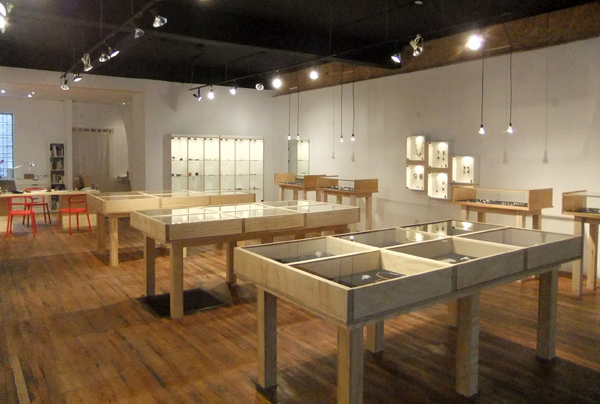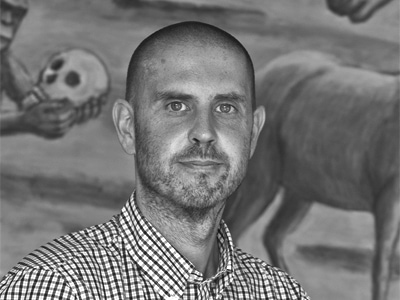Galleries exhibiting jewelry are an important part of our community and the people who run them have interesting backgrounds and stories to tell. In this interview Noel Guyomarc’h from Galerie Noel Guyomarc’h in Montreal, Canada answered some questions posed by Damian Skinner.

Noel Guyomarc’h: I had to move for many reasons. My landlord decided to increase my rent excessively at the same time as I realized that, to succeed in the existing location, I would need to do major renovations. From bad news, it became good news! It was perfect timing. I had been thinking about having a bigger space to host major exhibitions for a long time. Now I really enjoy this new space, and the response from my clientele makes me feel confident for the future.
How long has the gallery been open?
I opened the gallery in 1996. I am starting my sixteenth year.
Where did your interest in contemporary jewelry come from?
It came from a specific piece by one Montreal artist, Barbara Stutman. I was working as an assistant in a jewelry store, which had space dedicated to art jewelry. One day, Barbara Stutman brought in a bracelet made of few layers of pink, flesh-colored plastic tube held together by crocheted silver wire. I was really impressed by the fact that it looked like an organ to be worn, that you had to slip your hand through. That piece was part of an exhibition titled Plotting Our Progress/ l’État de la Femme. I started embracing the idea of jewelry as more than just decorative. I decided to educate myself by purchasing specialized books and magazines. As well, I met a number of jewelers such as Anne Fauteux, Alyssa Dee Krauss, Paul McClure and Barbara Stutman, to name a few.
How do you explain to someone who doesn’t know anything about contemporary jewelry what exactly you sell in the gallery?
My work as gallery owner is to promote my artists’ work and to educate people about it. With the exhibitions displayed, the clientele has no choice but to ask questions if they are opened to new ideas, new concepts, new aesthetics. I say that jewelry has been chosen by many artists as a personal way of expressing themselves and communicating with an audience. And, as Susan Cohn writes in her book Unexpected Pleasures, ‘Contemporary jewellery has experienced enough to have a history.’ We live in an important period for contemporary jewelry. We can refer to our own history, even if some links to fine arts still exist. Craft techniques are now employed in the visual arts.

It’s really difficult to answer such question. In my gallery, you can find a large selection of work. There is a diversity of work, some experimental with materials and new technologies, others with narratives that relate to design, work that is abstract and conceptual. To me, contemporary jewelry is the result of a questioning attitude, of a vision, of a reflection by an artist about the world, the environment, the community. I don’t define it by the materials and techniques used, but I am interested in new shapes, new forms new aesthetics. As soon as those criteria are included in a piece of jewelry, I open my eyes and have a closer look.
Tell us something about the contemporary jewelry scene in Canada. What’s the most notable thing about it from your perspective?
The quality of education, multiculturalism, curiosity and access to many sources of information have generated a new group of very interesting artists. Many professors and young jewelers did not hesitate to attend workshops and training abroad. I think the current generation has set up motivating bases. Being informed by different regions and provinces in Canada, contemporary jewelry offers a diverse and varied language. We find a similar momentum now to the one that Canada experienced in the late 1980s – and which unfortunately tailed off for various reasons (a lack of broadcasters and promotion, as well as economic reasons). A few Canadian artists have been selected for exhibition in Munich as part of Schmuck in the past ten years, including Sarah Troper, Greg Sims, Moira Roe, Silvie Altschuler, Geri Nishi and Annie Tung, to name a few. This year, Despo Sophocleous won the Herbert Hofmann Award, with Alexander Blank and Tore Svensson. In Quebec, you can find Lawrence Woodford, Gabrielle Desmarais and Anne-Marie Rébillard. And of course there are established artists such as Barbara Stutman, Anne Fauteux, Paul McClure, Janis Kerman, Pamela Ritchie, Kye Yeon Son, Bridget Catchpole and Catherine Allen.
Do you show jewelry from other countries as well as Canadian work?
I represent artists from Europe, the United States and Asia. Just to name a few: from Spain I work with Marc Monzó, Ramon Puig Cuyàs and Silvia Walz; from France, Monika Brugger and Maud Traon; from Germany, Mirjam Hiller; from Great Britain, Judy McCaig; from Japan, Meiri Ishida and Yu Hiraishi; from Korea, Jeehyun Chung; from Taiwan, Shu-Lin Wu; from Israel, Dina Abargil; from the Netherlands, Andrea Wagner and Uli Rapp; from Italy, Elisa Deval; from the United States, Anthony Tammaro, Arthur Hash, Kristi Sword, Sarah Abramson, Amy Tavern, Rebecca Hannon, Reiko Ishiyama and Donald Friedlich.
What are the three most interesting pieces of jewelry you’ve seen lately?
It is very difficult to select only three pieces . . .
Despo Sophocleous: This is the note from the jury at Schmuck: ‘Wearing Despo Sophocleous´ neck jewellery promises to be a sensual and acoustic experience. Out of simple individual white wooden tablets, this Canadian designer has created a playful composition in which the individual components are moveable. The work, entitled Change in direction 9, is a bit like a photograph, capturing a moment when the construction is on the point of collapse.’
Gabrielle Desmarais: Gabrielle is a young artist from Montréal. She graduated last year from the Montreal Jewellery School. She took part in a few workshops I gave on creative process and has succeeded, in my opinion, in developing a personal language.
Maud Traon: This ring is made of clay, plastic, varnish and glitter and is exaggerated, oversized on purpose. It is like magnifying a little princess ring!




